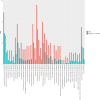Polygenic risk score for acute rejection based on donor-recipient non-HLA genotype mismatch
- PMID: 38820342
- PMCID: PMC11142483
- DOI: 10.1371/journal.pone.0303446
Polygenic risk score for acute rejection based on donor-recipient non-HLA genotype mismatch
Abstract
Background: Acute rejection (AR) after kidney transplantation is an important allograft complication. To reduce the risk of post-transplant AR, determination of kidney transplant donor-recipient mismatching focuses on blood type and human leukocyte antigens (HLA), while it remains unclear whether non-HLA genetic mismatching is related to post-transplant complications.
Methods: We carried out a genome-wide scan (HLA and non-HLA regions) on AR with a large kidney transplant cohort of 784 living donor-recipient pairs of European ancestry. An AR polygenic risk score (PRS) was constructed with the non-HLA single nucleotide polymorphisms (SNPs) filtered by independence (r2 < 0.2) and P-value (< 1×10-3) criteria. The PRS was validated in an independent cohort of 352 living donor-recipient pairs.
Results: By the genome-wide scan, we identified one significant SNP rs6749137 with HR = 2.49 and P-value = 2.15×10-8. 1,307 non-HLA PRS SNPs passed the clumping plus thresholding and the PRS exhibited significant association with the AR in the validation cohort (HR = 1.54, 95% CI = (1.07, 2.22), p = 0.019). Further pathway analysis attributed the PRS genes into 13 categories, and the over-representation test identified 42 significant biological processes, the most significant of which is the cell morphogenesis (GO:0000902), with 4.08 fold of the percentage from homo species reference and FDR-adjusted P-value = 8.6×10-4.
Conclusions: Our results show the importance of donor-recipient mismatching in non-HLA regions. Additional work will be needed to understand the role of SNPs included in the PRS and to further improve donor-recipient genetic matching algorithms. Trial registry: Deterioration of Kidney Allograft Function Genomics (NCT00270712) and Genomics of Kidney Transplantation (NCT01714440) are registered on ClinicalTrials.gov.
Copyright: © 2024 Cao et al. This is an open access article distributed under the terms of the Creative Commons Attribution License, which permits unrestricted use, distribution, and reproduction in any medium, provided the original author and source are credited.
Conflict of interest statement
The authors have declared that no competing interests exist.
Figures




Similar articles
-
Genome-wide meta-analysis associates donor-recipient non-HLA genetic mismatch with acute cellular rejection post-liver transplantation.Hepatol Commun. 2024 Dec 11;9(1):e0601. doi: 10.1097/HC9.0000000000000601. eCollection 2025 Jan 1. Hepatol Commun. 2024. PMID: 39670865 Free PMC article.
-
Donor and Recipient Polygenic Risk Scores Influence Kidney Transplant Function.Transpl Int. 2025 Mar 4;38:14171. doi: 10.3389/ti.2025.14171. eCollection 2025. Transpl Int. 2025. PMID: 40104404 Free PMC article.
-
Human leukocyte antigen-G donor-recipient matching of the 14-base pair polymorphism protects against cancer after heart transplant.J Heart Lung Transplant. 2020 Jul;39(7):686-694. doi: 10.1016/j.healun.2020.03.024. Epub 2020 Apr 7. J Heart Lung Transplant. 2020. PMID: 32317137
-
Polygenic risk scores in kidney transplantation.Curr Opin Organ Transplant. 2025 Jun 1;30(3):208-214. doi: 10.1097/MOT.0000000000001212. Epub 2025 Apr 1. Curr Opin Organ Transplant. 2025. PMID: 40171629 Review.
-
Donor-Recipient Non-HLA Variants, Mismatches and Renal Allograft Outcomes: Evolving Paradigms.Front Immunol. 2022 Apr 1;13:822353. doi: 10.3389/fimmu.2022.822353. eCollection 2022. Front Immunol. 2022. PMID: 35432337 Free PMC article. Review.
Cited by
-
Genomics in Pancreas-Kidney Transplantation: From Risk Stratification to Personalized Medicine.Genes (Basel). 2025 Jul 26;16(8):884. doi: 10.3390/genes16080884. Genes (Basel). 2025. PMID: 40869931 Free PMC article. Review.
-
Navigating Genetic Testing in Nephrology: Options and Decision-Making Strategies.Kidney Int Rep. 2024 Dec 27;10(3):673-695. doi: 10.1016/j.ekir.2024.12.020. eCollection 2025 Mar. Kidney Int Rep. 2024. PMID: 40225372 Free PMC article. Review.
References
-
- Opelz G, Wujciak T, Döhler B, Scherer S, Mytilineos J. HLA compatibility and organ transplant survival. Collaborative Transplant Study. Rev Immunogenet. 1999;1(3):334–342. - PubMed
MeSH terms
Substances
Associated data
Grants and funding
LinkOut - more resources
Full Text Sources
Medical
Research Materials

